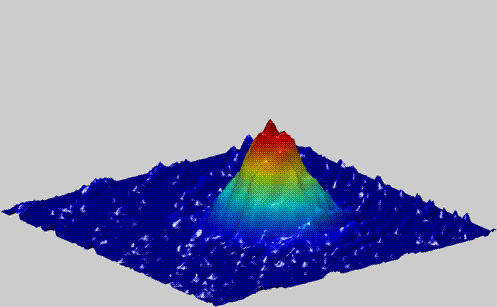Bose-Einstein Condensation of Chromium atoms


In all Bose-Einstein Condensates (BECs) realized so far, the dominant interaction stems from the isotropic contact potential due to s-wave scattering. Many new interesting features are predicted for a BEC where anisotropic, long-range interactions like the dipole-dipole interaction become important [1]. An ideal candidate for observing effects of the magnetic dipole interaction is atomic chromium with a large magnetic moment of 6 mB.
On the 25th November we have observed the first BECs of Chromium. We loaded about 300.000 52Cr atoms in a crossed optical dipole trap generated by a vertical (P=4.5W) and a horizontal (P=9.3W) beam of a fiber laser (1064 nm). Then we decreased the power in the horizontal beam slowly (approx. 10 s) to a few percent of its initial power. We then observe the cloud after a variable time of flight by absorption imaging. The movie shows typical data for a fixed time of flight of 5 msec after a 50 msec hold time. Between the individual pictures the final power in the horizontal beam is decreased in 0.5 % steps.
We observe first thermal clouds, then bimodal distributions and finally almost pure condensates. When released from an anisotropic trap the condensate shows the expected reversal of its aspect ratio for variable flight times (0-13 msec).
Preliminary analysis of our data suggests a Tc of ~400 nK and about 20000 atoms in the pure condensate. The preparation takes 40 seconds.
In the future we want to observe the dipolar character of the BEC. For that we plan to use one of the 14 Feshbach resonances that we have observed recently to tune the contact interaction vs. the dipole-dipole interaction to prepare a purely dipolar gas [2].
Especially its dipolar character, its special electronic properties and its applications in lithography make Chromium an interesting new player in the field of quantum gases.
References
[1] see for example: S. Giovanazzi, A. Görlitz, and T. Pfau, Phys. Rev. Lett. 89, 130401 (2002) and references therein.
[2] J. Werner, A. Griesmaier, S. Hensler, J. Stuhler, T. Pfau, A. Simoni, E. Tiesinga, Observation of Feshbach resonances in an ultracold gas of 52Cr, Phys. Rev. Lett. 94, 183201 (2005).
